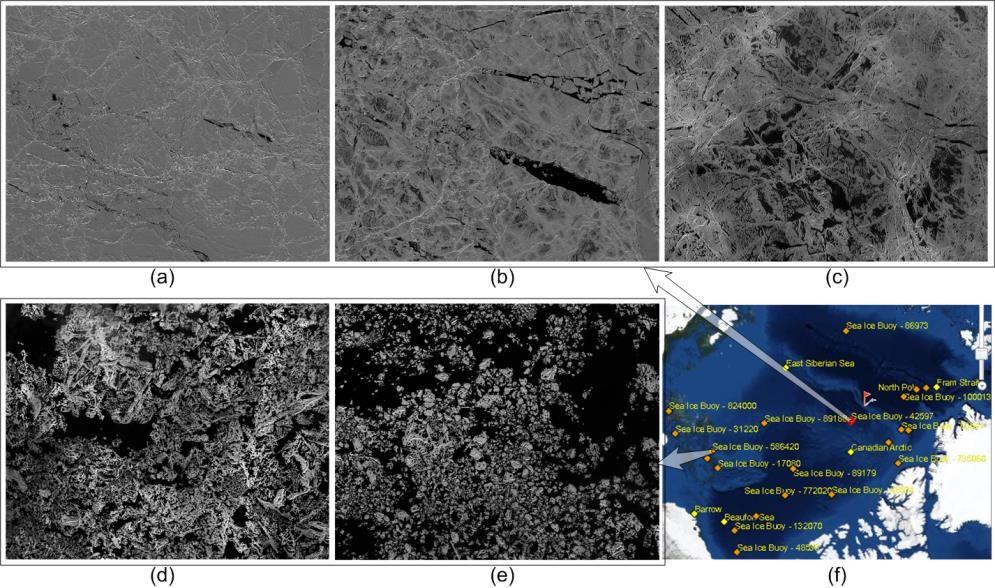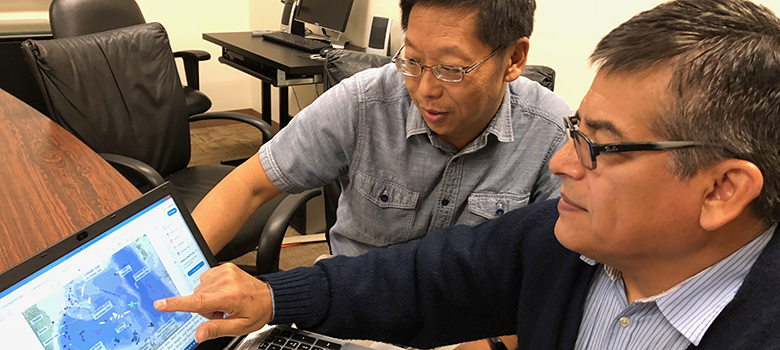
Examples of sea ice and melt-pond evolution in the Arctic Ocean
(Oct. 19, 2018) -- It’s called ArcCI (or Arctic CyberInfrastructure) and promises to combine the thousands of images that have been taken along the years of the Arctic Ocean into one global database that will help scientists and the world see the physical changes occurring in the region including ice loss. The hope is that this web-based repository will allow researchers to spend more time analyzing information rather than just collecting and processing data.
“This is to help scientists spend more time doing the science,” says Professor Alberto Mestas-Nuñez, one of two researchers at UTSA working on the on-demand data mining module. “At present time there isn’t a place on the internet that provides all these datasets but also an algorithm that allows to extract the information,” adds Mestas. “Most of the time scientists spend time getting data and preparing it. Typically, it’s about 80 percent preparing the data and 20 percent doing the actual science. We want to break that paradigm.”
The original idea to build ArcCI came from Professor Hongjie Xie, the principal investigator of the project at UTSA and a professor in the university’s Department of Geological Sciences. Although big data analytics, and dashboards are prevalent in many industries, the technology has yet to be applied fully to monitoring the Arctic’s sea ice.
“We have to harness the data revolution,” says Xie. “It’s about learning more in order to navigate the new Arctic.”

UTSA professors Hongjie Xie and Alberto Mestas-Nuñez examine images of sea ice in the Arctic Ocean.
Xie along with Xin Miao at Missouri State University started working on the project five years ago. Now the National Science Foundation has given the green light in the way of funding to develop the online system which uses high resolution imaging either obtained on-site, via satellites, or via airborne monitoring.
The system will allow the scientific community the ability to readily extract detailed information of various ice properties including submerged ice, ice concentration, melt ponds or ice edge—the boundary between an area of ice and the open sea. The on-demand database will be dynamic and allowed to include new algorithms as well as additional datasets as they become available. Currently, the cloud-based system holds about a terabyte of images but that number will surely grow. The earliest dataset is from 1998 from the Sheba expedition which conducted 13 flights over the Beaufort Sea. Now researchers will include close to 1760 declassified images.
“We will use the power of the image,” says Xie about the large amount of declassified information that will be integrated into ArcCI.
The cloud framework and interface is being prototyped by Chaowei Yang at George Mason University, another investigator partnering with UTSA. A beta version of ArcCI will be presented at the Fall Meeting of the American Geophysical Union to be held in Washington D.C. in December 2018.
This on-demand service module for mining the geophysical characteristics of the Arctic sea ice allows for a wider circle of the scientific community to have a smart tool that will enable them to conduct research in a digital modality. The project will also include summer workshops for educators so they can take advantage and they in turn teach the new landscape of the Arctic to the next-generation of scientists and kids.
Learn more about Professor Hongjie Xie’s Laboratory for Remote Sensing and Geoinformatics and the UTSA Department of Geological Sciences.
Connect with UTSA online at Facebook, Twitter, YouTube, Instagram and LinkedIn.
UTSA Today is produced by University Communications and Marketing, the official news source of The University of Texas at San Antonio. Send your feedback to news@utsa.edu. Keep up-to-date on UTSA news by visiting UTSA Today. Connect with UTSA online at Facebook, Twitter, Youtube and Instagram.
Move In To COLFA is strongly recommended for new students in COLFA. It gives you the chance to learn about the Student Success Center, campus resources and meet new friends!
Academic Classroom: Lecture Hall (MH 2.01.10,) McKinney Humanities BldgWe invite you to join us for Birds Up! Downtown, an exciting welcome back event designed to connect students with the different departments at the Downtown Campus. Students will have the opportunity to learn about some of the departments on campus, gain access to different resources, and collect some giveaways!
Bill Miller PlazaCome and celebrate this year's homecoming at the Downtown Campus with food, games, giveaways, music, and more. We look forward to seeing your Roadrunner Spirit!
Bill Miller PlazaThe University of Texas at San Antonio is dedicated to the advancement of knowledge through research and discovery, teaching and learning, community engagement and public service. As an institution of access and excellence, UTSA embraces multicultural traditions and serves as a center for intellectual and creative resources as well as a catalyst for socioeconomic development and the commercialization of intellectual property - for Texas, the nation and the world.
To be a premier public research university, providing access to educational excellence and preparing citizen leaders for the global environment.
We encourage an environment of dialogue and discovery, where integrity, excellence, respect, collaboration and innovation are fostered.